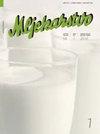Volatile compounds, antioxidant activity, ACE inhibitory activity, HMF content and microstructure of fruit yoghurts
IF 1.1
4区 农林科学
Q3 AGRICULTURE, DAIRY & ANIMAL SCIENCE
引用次数: 0
Abstract
Stirred-type fruit yoghurts with two different fruit purees (kiwifruit and banana) were produced and were investigated the physicochemical, volatile compounds, 2,2-diphenylpicrylhydrazyl (DPPH) free radical scavenging activity, cupric ion reducing capability (CUPRAC), total phenolic compounds (TPC), angiotensin-converting enzyme (ACE) inhibitory activity, 5-hydroxymethylfurfural (HMF) content, reducing sugar content and microstructure. The addition of fruit puree affected (p<0.01) total solids, fat, protein, ash, L*, a*, b*, volatile compounds, DPPH, CUPRAC, TPC, ACE inhibitory activity, HMF content, reducing sugar content and overall acceptability whereas it had an insignificant effect on the pH, titratable acidity, apparent viscosity, syneresis (p>0.05). Storage period significantly (p<0.01) affected the titratable acidity, DPPH, CUPRAC, TPC, ACE inhibitory activity, HMF content, reducing sugar content and overall acceptability, as well as the pH, apparent viscosity and a* (p<0.05). Although the addition of banana and kiwi relatively suppressed the characteristic flavour of the experimental yoghurt samples, it improved the DPPH, CUPRAC and TPC. On the other hand, the addition of banana-kiwi was found to increase the content of HMF, the toxic compound. Yoghurt can be recommended as an important source of bioactive compounds with ACE inhibitory activity. According to the microstructure analysis results, a more homogeneous structure was observed in the control group samples compared to the fruit-added yoghurt samples and it was determined that the serum pore diameters were smaller.水果酸奶挥发性成分、抗氧化活性、ACE抑制活性、HMF含量及微观结构
以猕猴桃和香蕉为原料,制备了搅拌型水果酸奶,并对其理化性质、挥发性成分、2,2-二苯基苦酰肼(DPPH)自由基清除能力、铜离子还原能力(CUPRAC)、总酚类化合物(TPC)、血管紧张素转换酶(ACE)抑制活性、5-羟甲基糠醛(HMF)含量、还原糖含量和微观结构进行了研究。果泥的添加对总固形物、脂肪、蛋白质、灰分、L*、a*、b*、挥发性化合物、DPPH、CUPRAC、TPC、ACE抑制活性、HMF含量、还原糖含量和总体可接受性有影响(p> 0.01),而对pH、可滴定酸度、表观粘度、增效作用无显著影响(p>0.05)。贮藏期显著影响了可滴定酸度、DPPH、CUPRAC、TPC、ACE抑制活性、HMF含量、还原糖含量和总体可接受性,以及pH、表观粘度和a* (p<0.01)。虽然香蕉和猕猴桃的添加相对抑制了实验酸奶样品的特征风味,但提高了DPPH、CUPRAC和TPC。另一方面,添加香蕉猕猴桃被发现增加了有毒化合物HMF的含量。酸奶可以作为具有ACE抑制活性的生物活性化合物的重要来源。微观结构分析结果表明,与果味酸奶样品相比,对照组样品结构更为均匀,血清孔径更小。
本文章由计算机程序翻译,如有差异,请以英文原文为准。
求助全文
约1分钟内获得全文
求助全文
来源期刊

Mljekarstvo
Agricultural and Biological Sciences-Animal Science and Zoology
CiteScore
1.90
自引率
41.70%
发文量
18
审稿时长
12 weeks
期刊介绍:
Mljekarstvo is an open access, peer-reviewed international quarterly scientific journal. The first issue was published in 1951, by the Croatian Dairy Operators'' Association (today: Croatian Dairy Union, publisher). In a paper at a Union conference held 28 October 1951 in Zagreb it was said: "Our desire is that this magazine does not meet the fate of its predecessors, but that it continues to reflect the creative efforts and to provide guidelines for the producers as well as all other operators employed in the dairy industry."
It is our pleasure today to say that wishes of the enthusiasts who attended the conference have come true, and the magazine Mljekarstvo during the last six decades was a reflection of the creative efforts of numerous dairy scientists and experts, and through its texts it served as a guideline in improving production and processing of milk and dairy products. Mljekarstvo has been following all the achievements of the dairy profession in Croatia, and it also gives the short surveys of world achievements. The result of the research of local and foreign scientists and experts always find their place in the magazine Mljekarstvo. It has been edited by our outstanding dairy experts employed at colleges, research institutions and dairy companies.
 求助内容:
求助内容: 应助结果提醒方式:
应助结果提醒方式:


